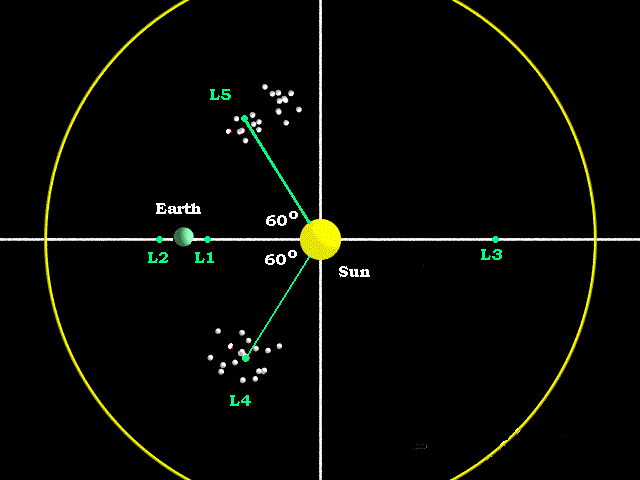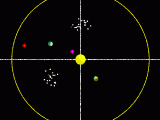
Martin Connors
Centre for Natural and Human Science, Athabasca University, Athabasca Alberta CANADA
Christian Veillet
Canada-France-Hawaii Telescope, Mauna Kea, Hawaii USA
Paul Wiegert
Dept. of Physics, UWO, London Ontario, N6A 3K7 CANADA
Kimmo Innanen
Dept. of Physics and Astronomy, York University, Toronto Ontario, M3J 1P3 CANADA
Seppo Mikkola
Tuorla Observatory, University of Turku, 21500 Piikkio FINLAND
If you put an asteroid exactly on the same orbit as the Earth, what would happen? Would it stay on the orbit? Drift away? Or crash into our planet? The answer depends on exactly where you place the asteroid. There are five points on or near the Earth's orbit, known as the Lagrange points, where an asteroid will remain stationary with respect to the Earth. The locations of the Lagrange or L-points are shown below.
 |
If asteroids were placed exactly on the L-points and there were no perturbations (not even the small ones caused by the other planets in the Solar System), they would stay there indefinitely. But because there are these perturbations, asteroids at the L1, L2 and L3 points will wander away over time: only the L4 and L5 points are stable. And thus, there may be asteroids orbiting there. It is the objective of this collaboration to discover them.
There are in fact a variety of positions near the L4 and L5 points which can also maintain asteroids in a stable fashion, though these asteroids will not remain perfectly stationary with respect to the Earth (some hypothetical members of this asteroid group are shown above). For an MPEG animation of a simulation of these particles' motions, click here.

|
All the planets in our Solar System have Lagrange points, just as Earth does. As of July 27 2011, thousands of asteroids have been discovered near Jupiter's L4 and L5 points, and four at Mars' and seven at Neptune's. Only one currently known for the Earth, 2010 TK7. Jupiter's asteroids were intially all named after heroes of the Trojan Wars, and thus these types of asteroids are often called "Trojans" for short.
Hypothetical flight through the L4 point
Here we present a view of the motion of asteroids at the Earth's
Lagrange points. This animation shows a scene which begins from a
vantage point above the Solar System. The camera matches the Earth's
velocity, traveling along to touch down on the "top" of the Earth, all
the while looking at the L4 point. After a brief stop, the camera
flies through the L4 cloud and finishes its journey pointing back
towards the Earth, which can be seen on the right-hand edge of the
screen. Note that the size of the Sun, planets and the hypothetical
asteroids has been greatly exaggerated in all the sims and figures to
aid visibility.
Asteroids on Earth's orbit
In this computer simulation, 23 asteroids are placed on the Earth's
orbit at 15 degree intervals, to see what would happen. The simulation
runs for a 1 million years. All the planets' influences are accounted
for though not all can be seen in the frame. None of the asteroids
collide with the Earth, and none escape. Counter to intuition, the
asteroids avoid the Earth, which ends up sitting in a gap. The
dynamics of the situation actually cause the asteroids to keep their
distance. Asteroids are colour-coded according to their initial
position: note that at the end most remain clustered on their original
side, though it is possible for bodies to pass from the vicinity of
one L point to the other. Also note that, after a million years, most
asteroids are no longer on perfectly circular orbits, gentle
"stirring" by the planets has altered their orbits somewhat.
Note that this page is not actively maintained: some information may be out of date. Other MPEG movies
Related links
Have a question or comment? Email Paul Wiegert at pwiegert[remove this and put the @ symbol here]uwo.ca
Earth Lagrange and Trojan asteroid main page
© Copyright 2000-2021 by Paul Wiegert